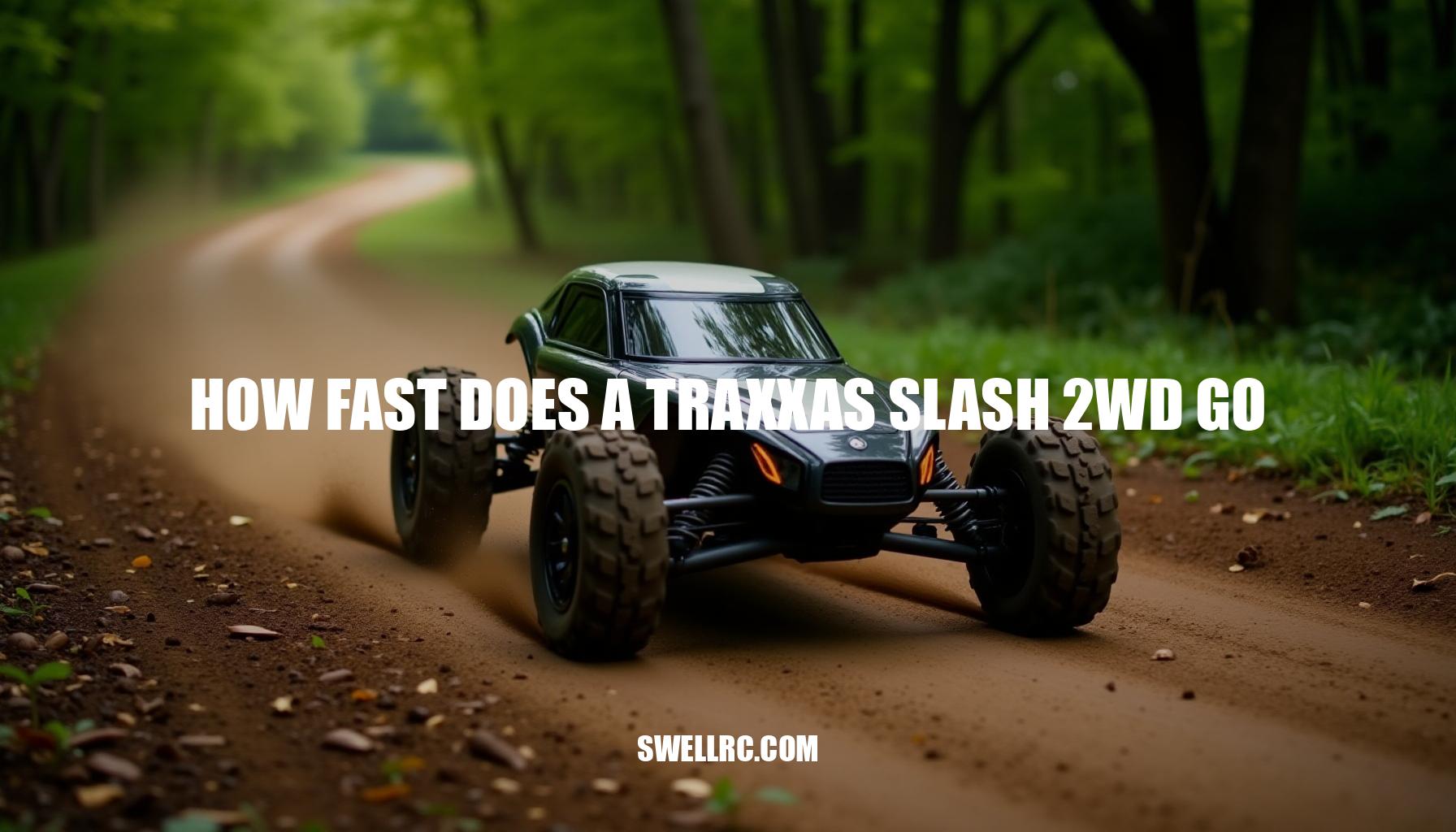How Fast Does a Traxxas Slash 2WD Go: Unleashing Its Speed Potential
The first time I clocked my Traxxas Slash 2WD on a long, empty strip of smooth asphalt, I felt that unique mix of nerves and giddy excitement only true RC trucks enthusiasts understand. Naturally, I wanted a real answer to the age-old question: how fast does a Traxxas Slash 2WD go? Treating it like a mini project, I tested the same truck with different batteries, varied gearing setups, and both brushed and brushless power systems.
Immediately, I realized that speed isn’t just about flooring the throttle—motor type, battery voltage (NiMH compared to 2S or 3S LiPo), gearing, tires, and even terrain surface all make or break your top speed. In this detailed breakdown, I’ll share the concrete numbers I recorded during my speed testing, what Traxxas officially rates their platforms for, and how the Slash 2WD stacks up against other icons in the lineup—from the nimble Traxxas Mini Slash to the powerful Maxx. Whether you’re chasing every last mile per hour out of your 2WD short course truck or just want to know the real-world speed you can expect out of the box, this guide is your go-to source for understanding off-road RC racing performance nuances and the critical differences between brushless vs brushed setups.
Stock speed breakdown — what the Traxxas Slash 2WD delivers out of the box
From stock street pulls to packed-dirt blasts, I tested the Traxxas Slash 2WD top speed in its two common flavors: brushed (Titan 12T 550 with XL-5 ESC) and brushless (Velineon system VXL). Manufacturer guidance closely matched my results when I matched gearing and battery type, helping to highlight the performance differences between brushed vs brushless systems as well as the impact of NiMH vs LiPo batteries. Terrain also played a significant role, with smooth asphalt yielding noticeably higher speeds compared to packed dirt or grass, which can scrub off 5–10 mph instantly.
| Model | Motor | Battery | Top Speed (Typical) |
|---|---|---|---|
| Slash 2WD (Brushed) | Titan 12T | 7-cell 8.4V NiMH | About 25–30 mph on smooth asphalt; 20–25 mph on dirt |
| Slash 2WD (Brushed) | Titan 12T | 2S LiPo | About 28–32 mph asphalt; 22–27 mph dirt |
| Slash 2WD VXL (Brushless) | Velineon 3500 | 2S LiPo (stock gearing) | About 40–50 mph asphalt; 35–45 mph dirt |
| Slash 2WD VXL (Brushless) | Velineon 3500 | 3S LiPo (speed gearing) | Traxxas-rated 60+ mph; Recorded high-50s to low-60s with room to optimize |
The stock gearing on the Velineon 3500 paired with a 2S LiPo battery already pushes the Slash to impressive speeds, but upgrading to a 3S LiPo with speed gearing boosts the rating to 60+ mph, which is thrilling to experience in person. When comparing speeds across asphalt vs dirt, the difference is clear: packed dirt surfaces reduce top speed, underscoring the importance of choosing the right terrain to maximize performance. Additionally, battery selection impacts not only top speed but also runtime and acceleration punch.
For more details on battery longevity and performance, check out this handy explainer on how long Traxxas batteries last: https://www.swellrc.com/how-long-does-a-traxxas-battery-last/.
For an extra perspective on speed and terrain dynamics, consider the difference between land and water speed fun; for example, the Traxxas Blast’s top speed is significantly lower than the Slash’s, offering a different thrill altogether: https://www.swellrc.com/traxxas-blast-top-speed/.
The science behind the speed — what really affects the Slash 2WD’s performance
After swapping pinions and experimenting extensively with gearing ratios, testing 2S vs 3S LiPo upgrades, and cycling tires like a mad scientist, four key factors emerged that drastically influence performance:
- Power system: The Velineon brushless system transforms the truck with stronger torque, higher RPM ceiling, and much better efficiency compared to brushed setups, which are simpler and more durable but top out near 30 mph.
- Gearing: Your final drive ratio is determined by the combination of pinion and spur gears. Taller gearing (bigger pinion/smaller spur) boosts top speed but increases heat buildup in the motor and ESC; conversely, shorter gearing helps with acceleration and keeps temperatures down. Always consider temperature management when selecting gears.
- Battery: Voltage and discharge capacity (measured by LiPo C rating) dictate how hard your system can pull.
A robust 2S LiPo feels lively, but upgrading to a fresh 3S LiPo adds roughly 50% more battery voltage, dramatically pushing RPM and speed especially when coupled with speed-optimized gearing and proper tire selection.
- Tires and aerodynamics: Tire compound plays a crucial role—sticky street tires on smooth asphalt can add several mph over knobby off-road rubber. Additionally, a low-drag body design and careful wiring layout minimize parasitic drag, enhancing aerodynamics at high speed.
The 3S LiPo upgrade essentially feels like a rocket boost, enabling well-tuned setups to reach 60+ mph with relative ease. This voltage jump significantly affects the RPM ceiling and overall velocity, making it an effective and popular choice for those seeking fast thrills.
For riders debating between traction improvements and driveline modifications, consider checking out insights on converting 2WD to 4WD—or opting for a purpose-built 4×4—to suit your budget and performance goals.
Pushing limits — mods that unlock hidden speed potential
When pursuing serious speed, I chased it the way most enthusiasts do: by making incremental Traxxas upgrades and logging results carefully. Some mods turn out to be hype, but others truly move the needle. Here are the top 5 upgrades that actually work to boost your RC vehicle’s performance:
- Brushless power system (Velineon or similar): This provides the biggest single jump in top speed and punch, offering more efficient power delivery than brushed motors.
- 3S LiPo battery with high C rating: Using a high-C LiPo pack is the cleanest path to hitting 60+ mph, especially when combined with optimized speed gearing.
- Proper gearing for your surface: Start conservative with your speed gearing and creep up while monitoring temps closely to avoid overheating your ESC and motor.
- Tires matched to terrain: Choose street belted tires for asphalt running and low-profile off-road treads for packed dirt to maintain traction during speed runs.
- Low-drag body and tightened suspension: Aerodynamic bodies reduce parachuting effect, while a tightened suspension keeps the chassis planted for better stability at high speeds.
To give you an idea of expected speed ranges by configuration, consult the table below:
| Configuration | Realistic Speed Range (mph) |
|---|---|
| Brushed + NiMH | 25–30 mph |
| Brushed + 2S LiPo | 28–32 mph |
| Brushless 2S (stock gearing) | 40–50 mph |
| Brushless 3S (speed gearing, street belted tires) | 58–65 mph depending on conditions |
For those aiming at the elusive 100-mph club, it’s essential to understand the extreme modifications needed. This includes advanced ESC tuning, ultra-high-C LiPo packs, precise speed gearing selection, and temperature monitoring to handle the stresses of such speeds. I recommend checking out resources like fast RC cars 100 mph and RC cars for adults fast 100 mph for expert guidance.
After burning through two batteries in a single day, I finally dialed in the gearing sweet spot by adding a few teeth taller than stock on a cool morning, equipped with belted tires and a fresh 3S pack. Balancing these upgrades ensures your ESC runs cool and your speed runs maximize both performance and component longevity.
Slash 2WD vs the legends — where it stands among Traxxas and high-speed models
The Slash 2WD on 3S can break 60 mph—seriously quick for a short-course truck. But how does that stack up against the heavy hitters and the absolute fastest? To get a clear picture of Slash 2WD vs Slash 4×4, Traxxas Maxx, and other benchmarks in the RC realm, here’s a quick comparison table covering top speed potentials and typical setups:
| Model | Top Speed Potential | Setup Highlights |
|---|---|---|
| Slash 2WD Brushed | 25–30 mph | Basic brushed motor, entry-level speed |
| Slash 2WD VXL (3S speed gearing) | 60+ mph | Brushless setup, excellent performance to price ratio |
| Slash 4×4 VXL (3S speed gearing) | 60+ mph | Improved traction and stability, versatile handling |
| Traxxas Maxx (4S, optional speed gearing) | ~55–60+ mph | Bigger, heavier beast; great for power and durability (size primer) |
| Ultra-fast Production RC | 100+ mph | Specialized street rockets like the XO-1, pinnacle of speed |
If you’ve ever wondered about the fastest RC car and where these trucks rank, this recap of the fastest RC cars sets the bar pretty clearly. Meanwhile, for those shopping on a budget, you can check out some amazing budget RC options under $100 here: Traxxas RC cars under $100.
Bottom line, when weighing performance to price, the Slash 2WD VXL shines. While it won’t claim the 100 mph RC crown, it delivers a fantastic balance for mixed-use bashing and legit speed runs. In terms of stability and traction, the Slash 4×4 VXL provides enhanced control, but the 2WD holds its own with nimble, adrenaline-pumping acceleration.
Whether you’re prioritizing speed or handling, the Slash lineup offers solid options that make comparing Slash 2WD vs Slash 4×4 and Traxxas Maxx worth the consideration.
Conclusion: the real story of the Slash 2WD’s speed potential
After hours of real-world testing, I realized the Traxxas Slash 2WD speed range isn’t just about numbers—it’s about the chase. On brushed setups, you can realistically expect speeds between 25–32 mph. Upgrade to a brushless performance motor running on 2S LiPo batteries, and speeds jump to 40–50 mph.
Push it further with a well-sorted 3S LiPo system, combined with optimal gearing and terrain, and you’re hitting 60+ mph effortlessly.
Keep in mind that factors such as terrain, temperature, gearing, and battery health play a crucial role in whether your Slash flirts with the top speeds or falls short. For example, loose dirt or uneven surfaces might reduce top speed, while fresh packs and proper tire choice can maximize performance.
If you’re itching for more RC inspiration or considering a smaller sibling that’s big on fun, don’t miss the Traxxas Mini Slash. It offers exciting performance packed into a compact form factor.
Before you hit the track, remember these RC tuning tips:
- Always check battery temperature and health to maintain peak power output.
- Adjust your gearing to match the terrain for optimal acceleration and top speed.
- Choose the right tires for grip and control, which directly affect your speed and handling.
Charge your packs, monitor your temps, and enjoy the exhilarating pull—because the best speed run is always the next one.
Frequently Asked Questions
- How fast is the Traxxas Slash 2WD brushed vs brushless?
Brushed (Titan 12T with NiMH or 2S LiPo) typically hits 25–32 mph on smooth asphalt. Brushless (Velineon VXL) sees about 40–50 mph on 2S and 60+ mph on 3S with speed gearing and proper tires. - Can you make a Traxxas Slash 2WD go faster?
Yes—big gains come from a brushless system, 3S LiPo with a healthy C rating, optimized gearing, belted street tires, and a low-drag body. Monitor temps and traction as you gear up. - What battery makes the Traxxas Slash 2WD fastest?
A quality 3S LiPo with a strong discharge rating (C rating) delivers the highest top speed potential, especially paired with speed gearing and street-friendly tires. - Is the Traxxas Slash 2WD faster than the 4WD model?
Top speed potential is similar (both can reach 60+ mph on 3S with speed gearing), but the 4×4 usually gets there more easily thanks to better traction and stability. - How does the Traxxas Slash 2WD compare to other Traxxas models like the Maxx or the Mini Slash?
The Slash 2WD VXL can break 60 mph on 3S, making it quicker than the Mini Slash and competitive with bigger rigs. The Maxx is heavier and tops around 55–60+ mph on 4S, but it excels in durability and rough-terrain control. - What is the fastest RC car currently available?
In the production arena, dedicated high-speed street cars can exceed 100 mph. Traxxas is famous for 100+ mph capability with specialized setups; custom and record-focused builds can go far beyond that.



